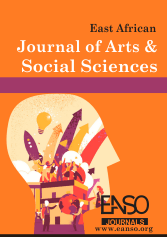School-Based Stress and Social Pressure on the Mental Health and Psychosocial Well-being among Secondary School Students in Uganda
Abstract
School-based stress and social pressure have increasingly emerged as major determinants of mental health challenges among secondary school students in Uganda. Stress arising from poor academic performance is ranked as the leading cause of mental health concerns, followed by family-related issues of domestic violence, bullying, depression, anxiety, bereavement, suicidal ideation, and physical or sexual violence. The study investigates the extent to which these factors shape students’ mental health and psychosocial well-being, while examining the coping mechanisms and the role of teachers and school administrators in offering support. Employing a qualitative exploratory research design, data were collected from secondary school students in three districts of Uganda to assess the prevalence and implications of stressful academic demands, unrealistic societal expectations, and institutional pressures. The findings revealed that students aged 15 years and above are increasingly vulnerable to psychological distress that manifests in low self-esteem, emotional exhaustion, poor self-efficacy, and academic underachievement. Some students still struggle with negative self-perceptions, which end up affecting their self-confidence, emotional well-being, and behaviour. The study highlights the urgent need for holistic interventions that involve not only students and educators but also families, communities, and policymakers. This research recommends contextually relevant strategies to mitigate school-related stressors and contribute to policy dialogue on mental health education. It emphasises the necessity of supportive school environments that can foster resilience and holistic development of students.
Downloads
References
Globally, between 10-20% of children and adolescents are affected by mental health problems of varying types (Schulte-Körne, 2016; Patel et al., 2018; Polanczyk et al., 2015). These conditions often manifest in attention difficulties, poor motivation, cognitive disturbances, and, in some cases, persistent low moods, which significantly impair academic achievement. Despite this recognition, there is still limited explanation regarding the specific school-related factors that contribute to mental health challenges and the effectiveness of preventive and school-based interventions (Kieling et al., 2011; Patel et al., 2018).
Mental health disorders are now recognised among the leading causes of morbidity and disability worldwide (WHO, 2022; Vos et al., 2020; Whiteford et al., 2013). The World Health Organization estimates that one in four individuals will experience a mental disorder during their lifetime, with approximately 450 million people currently affected globally. Among children and adolescents, about 20% suffer from these conditions, contributing to nearly 16% of the total global burden of disease and injury in this age group (Patel et al., 2018; Vos et al., 2020). Adolescence is a particularly sensitive developmental stage marked by heightened vulnerability to risk-taking behaviours and mental health difficulties, which may be intensified by peer influence, academic pressure, and examination anxiety (Sawyer et al., 2012; Steinberg, 2014).
In Uganda, mental health remains a relatively neglected and under-sourced area due to competing priorities and resource limitations (Ssebunnya et al., 2009; Molodynski et al., 2017; Kinyanda et al., 2013). There is a shortage of trained personnel, insufficient institutional support, and limited integration of mental health services into schools and primary health care. Relatedly, adverse life events such as poverty, family instability, and exposure to violence have further compounded the risk of psychological distress among the young people (Kinyanda et al., 2013). These gaps highlight the urgent need to assess the scale of psychosocial distress among students in order to inform locally relevant and sustainable intervention strategies.
This study, therefore, seeks to examine how school-based stressors and social pressures affect the mental health and psychosocial well-being of secondary school students in Uganda. The findings are expected to provide evidence that can guide educational and health policy, particularly in integrating mental health care services into school programs. This is aligned with global development priorities in Sustainable Development Goal 3, which emphasises the promotion of mental health and well-being alongside the prevention and control of non-communicable diseases (Goodwin & Zaman, 2023; Patel et al., 2018; United Nations, 2015).
This study shall focus on the Transactional Model of Stress and Coping developed by Lazarus and Folkman (1984), which suggests a framework for demystifying the interplay of academic stress, performance pressure, mental health, and psychosocial well-being among students. According to this model, stress results from the dynamic interaction between individuals and their environment, wherein academic stress and performance pressure serve as external stressors that students encounter. These stressors undergo a cognitive appraisal process where students evaluate school-based demands in terms of those that are likely to be threatening and those that are manageable. The model further highlights the pivotal role of students' perceptions in shaping their coping strategies, which can either be adaptive or maladaptive. According to the model, adaptive coping strategies, such as seeking support and problem-solving, are likely to foster positive mental health outcomes, including emotional equilibrium and enhanced psychosocial well-being. Conversely, maladaptive coping mechanisms like avoidance or rumination may exacerbate stress, thereby contributing to the development of mental health issues of anxiety, depression, and burnout (Kivak, 2020).
Problem
School-based stress is an increasing concern among secondary school students, with significant implications for mental health, psychosocial well-being, and academic performance. Globally, one in seven adolescents experiences a mental health disorder, and academic pressure remains a major contributor to this trend (WHO, 2021). In Uganda, the problem is intensified by high-stakes examinations such as the Uganda Advanced Certificate of Education (UACE) and Uganda Certificate of Education (UCE), compounded by limited psychosocial support services, overcrowded classrooms, and rigid curricula. Previous studies have shown that academic stress contributes to anxiety, insomnia, and depression, yet interventions in secondary schools remain inadequate and policy responses limited (Deb et al., 2015).
Although this challenge has been acknowledged, most existing studies remain concentrated on university students and, to some extent, in urban environments (Kaggwa et al., 2022; Kiweewa et al., 2018). This narrow focus neglects secondary schools, particularly in rural and resource-constrained contexts, where students often experience unique psychosocial stressors. The gap has serious consequences on students: diminished self-esteem, increased school dropout, strained family relations, and the risk of producing a workforce that is academically trained but emotionally fragile (World Bank, 2008; Oketch & Rolleston, 2007). The study seeks to contribute by examining the realities within these underserved settings. Specifically, it investigates the influence of school-based stress and social pressure on the mental health and psychosocial well-being of students in Uganda. The findings aim to inform evidence-based strategies that can promote resilience, balance academic achievement with emotional health, and strengthen support systems within the school settings.
LITERATURE REVIEW
School-Based Stress and Mental Health
School-based stress is a significant predictor of mental health outcomes among adolescents. Globally, research has shown that heavy academic workloads, demanding curricula, and pressure of high-stakes examinations create psychological strain, often leading to anxiety, depression, and burnout (Ringdal et al., 2020). In Uganda, the majority of secondary school students experience high stress levels due to the national examinations, which determine progression to higher education and future employment opportunities (Kaggwa et al., 2022). The fear of failure and academic underperformance has been linked to increased cases of anxiety disorders, emotional exhaustion, and suicidal ideation among adolescents (Abbo et al., 2019). Nonetheless, the majority of these studies have focused either on university students or adolescent populations in urban areas, with little attention given to rural and resource-constrained secondary schools. The present study, therefore, seeks to address this gap by examining the first research question: What is the influence of school-based stress on the mental health of students in secondary schools in Uganda?
School-Based Stress and Psychosocial Well-Being
Beyond clinical mental health outcomes, school-based stress exerts profound effects on students’ psychosocial well-being. Stress associated with academic demands has been linked to low self-esteem, poor social functioning, reduced participation in extracurricular activities, and weakened family relations (Freeman, 2024; Anyanwu, 2023; Ssenyonga et al., 2023). For Ugandan students, the long school days and exam-centred learning environments leave little time for peer interaction, leisure, or bonding, thereby limiting opportunities to build healthy social networks.
Some studies have indicated that chronic academic stress often fosters feelings of isolation and inadequacy when students fail to meet the academic benchmarks (Freeman, 2024; Ssenyonga et al., 2023). A study in Central Uganda stressed that academic stress contributes to diminished self-confidence, strained peer relations, and disengagement from school life (Nalugya-Sserunjogi et al., 2016). Despite these findings, psychosocial outcomes have not received as much research attention as clinical outcomes such as depression or anxiety. This neglect underscores the importance of the second research question: What is the influence of school-based stress on the psychosocial well-being of adolescent students in Uganda?
Social Pressure and Mental Health
In addition to the academic workload, external social pressures significantly shape students’ mental health outcomes. Parents, teachers, and peers often impose high expectations on students, equating academic performance with personal worth. Studies from Uganda show that adolescents internalise these expectations, which leads to heightened stress and vulnerability to mental health conditions (Kaggwa et al., 2022; Kiweewa et al., 2018). When students perceive themselves as failing to meet these expectations, they may experience guilt, shame, and emotional distress, which increases the risk of depressive symptoms and poor psychological adjustment (Ichwani et al., 2024).
Given the strong role that social pressure plays in adolescent mental health, particularly in examination settings with significant academic and career progression prospects (Tobias, Thursday, January 20th, 2025), there is a need to explore how such factors may affect secondary school students in Uganda. Hence, the third research question: How does social pressure impact the mental health of adolescent students in secondary schools in Uganda?
Social Pressure and Psychosocial Well-Being
Research findings in Sub-Saharan Africa suggest that social pressure significantly influences students’ psychosocial well-being, often shaping their emotional adjustment and a sense of belonging in school environments (Musiimenta et al., 2021; Govender et al., 2019). Within competitive academic settings, peer comparisons have been shown to undermine self-esteem, intensify feelings of inadequacy, and heighten social isolation among students (Ngabirano et al., 2020; Owiny, 2025). In Uganda, studies have demonstrated that students who fail to meet expected performance standards frequently experience diminished self-confidence, strained family and peer relationships, and, in many cases, social withdrawal (Ssenyonga et al., 2023; Ssewamala et al., 2020; Nalugya-Sserunjogi et al., 2019). In more severe cases, adolescents under intense social pressure end up adopting maladaptive coping strategies such as substance abuse or self-harm (Abbo et al., 2019).
These findings suggest that performance-driven education systems, while fostering academic competition, may inadvertently weaken students’ socio-emotional resilience. However, literature evidence on how social pressure influences the psychosocial well-being among secondary schools remains scarce. The fourth research question, therefore, asks: What is the influence of social pressure on psychosocial well-being among secondary school students in Uganda?
MATERIALS AND METHODS
Research Design
A qualitative exploratory design was employed to gain in-depth insights into students’ lived experiences of school-based stress and social pressure. This approach was appropriate for the exploration of psychosocial dimensions that may not be captured through quantitative methods. It provided rich, contextual insights into participants’ lived experiences, coping mechanisms, and emotions. This enabled the study to explore different dimensions of students’ well-being in the school setting.
Study Area and Population
The research was conducted in Kampala, Jinja, and Kyotera districts of Uganda, representing urban, peri-urban, and rural educational contexts. This selection allowed for comparison across diverse educational settings of lower and higher levels of secondary education. The study population comprised adolescent girls and boys aged 15-17 years enrolled in secondary schools. This age group was particularly of interest due to its vulnerability to school-related stress and peer pressure.
Sampling and Selection of Participants
Using purposive sampling, a total of 115 adolescents aged 15-17 years were selected from five secondary schools across Kampala, Jinja, and Kyotera districts to capture perspectives from urban, peri-urban, and rural contexts. The sample included both boys (n = 56) and girls (n = 59), ensuring gender representation and diversity across the school settings and academic levels. The distribution is presented in Table 1.
Table 1: Distribution of Participants by Gender and District
GENDER KAMPALA JINJA KYOTERA TOTAL
Boys 10 34 12 56
Girls 10 31 18 59
Total 20 65 30 115
Source: Field Data (2025)
Purposive sampling was employed to deliberately recruit participants with direct experience of school-related stress, social pressure, and psychosocial challenges. This non-probability approach was considered appropriate for qualitative inquiry, as it facilitated the selection of information-rich cases capable of providing an in-depth understanding of the phenomena under investigation.
Data Collection Procedure
Semi-structured interviews were conducted to explore students' personal experiences and perceptions of school-related stress and social pressure on their mental health. The interview guide enabled participants to express richer and more detailed insights into the challenges faced, coping strategies, and practical suggestions. To ensure confidentiality and comfort, interviews were recorded with participants’ consent and school authorities' permission. These were subsequently transcribed verbatim.
Focus Group Discussions (FGDs), on the other hand, complemented the interviews by capturing shared experiences, group dynamics, and collective viewpoints. Small groups, segmented by age and gender where appropriate, were encouraged to increase open dialogue. The FGD guide was used to regulate the conversations on academic pressure, peer influence, and school support systems, while ensuring balanced participation. All FGDs were audio-recorded, transcribed, and anonymised for analysis with participants' consent and school permission.
Ethical Considerations
Permission to conduct the study was obtained from the respective school authorities. The purpose of the research was clearly explained to school heads, teachers, and students prior to participation. Informed consent was sought from all students who voluntarily agreed to take part in the study. Participants were informed of their right to decline or withdraw at any stage without consequences.
To ensure confidentiality and anonymity, no personal identifiers were used in transcripts or reports; instead, participants were assigned codes. All interviews and focus group discussions were conducted in private and supportive environments, with information handled securely and used solely for academic purposes.
Data Analysis
Data from semi-structured interviews and focus group discussions (FGDs) were transcribed verbatim and analysed using thematic analysis, which was deemed appropriate for identifying and interpreting patterns within qualitative data. The analysis followed a systematic process of repeated reading to ensure familiarity, coding meaningful segments, and clustering codes into categories and overarching themes (Braun & Clarke, 2006). This approach facilitated the exploration of how school-based stress and social pressure influence students’ mental health and psychosocial well-being.
To enhance the credibility of the findings, triangulation was applied by comparing data sets. Reflexive note-taking during the analytic process was used to minimise researcher bias, while careful documentation of analytic decisions ensured transparency. Themes were supported with representative quotations to retain the voices of participants.
RESULTS
This study investigated the mental health and psychosocial well-being of adolescents in selected secondary schools in Uganda, focusing on school-based stress and social pressure. The analysis of interviews and focus group discussions revealed four major thematic areas: (1) academic stress and mental health, (2) academic stress and psychosocial well-being, (3) social pressure and mental health, and (4) social pressure and psychosocial well-being.
The Influence of School-Based Stress on Mental Health
Academic stress emerged as a pervasive challenge among students across all the districts. Many participants reported feeling overwhelmed by heavy workloads, frequent examinations, and high expectations from teachers and parents. Students described persistent worry about disappointing their families, with some equating poor performance to personal failure. The resulting symptoms included anxiety, low mood, insomnia, loss of appetite, and psychosomatic complaints. Some students developed maladaptive coping strategies, such as aggression, withdrawal, or excessive reliance on stimulants to remain alert for late-night study sessions. For example, seven Senior Three boys admitted to chronic worry about their future, particularly regarding subject choices. A-level. One O-level male student explained:
“I am doing well in all subjects. But I am not sure which subjects I shall do at A’ Level. I feel like I have too many options, but if I select the wrong path, I am finished.”
This narrative reflects the intense fear and uncertainty students face during subject selection at A’ Level, a process that is closely tied to their future career and world of work. Even high-performing students experience deep anxiety about making the “wrong” choice, which suggests that the education system creates a pressure-filled environment where students believe that a single academic choice could determine the course of their future.
The Influence of School-Based Stress on Psychosocial Well-Being
The effects of academic stress extended beyond mental health, disrupting students’ social relationships and participation in school life. Students from economically disadvantaged families, especially those who had lost a parent, reported heightened vulnerability. Senior Six students who had lost their fathers described instability in caregiving arrangements and difficulty in forming friendships due to frequent relocations. In this regard, female students highlighted financial barriers to extracurricular activities like study trips and sports, which they felt limited their ability to fully engage with the new curriculum. One Senior Five female students observed:
“Sometimes, I feel like I may never excel in the new curriculum because if I cannot go for a certain trip, how will I attempt some aspects of the project work?”
This student’s reflection illustrates how financial barriers interface with academic expectations to exert psychosocial stress on students. The inability to participate in study trips and extracurricular activities may create feelings of exclusion and self-doubt, particularly when such activities are tied to curriculum requirements. This suggests that stress is not only produced by academic workloads but also by inaccessibility to learning opportunities. This implies that students from low-income families may experience the psychological burden of being unable to meet curricular demands and the social strain of feeling left out among peers. Without systemic measures such as subsidised participation in mandatory activities, the new curriculum risks widening disparities in psychosocial well-being between students of different socioeconomic backgrounds.
The Influence of Social Pressure on Mental Health
Study participants reported intense pressure from both home and community to excel academically, often without adequate socio-emotional support. Boys in particular described limited communication with parents as well as fearing negative reactions to poor grades. As one Senior Four male student shared:
“The optional subject I am doing was chosen by my parents. However, I find them very difficult to understand, yet I have nothing to do. For now, let me struggle with my performance until the end.”
Similarly, female students raised additional concern from community members who undermined their extracurricular efforts, interpreting it as a neglect of domestic responsibilities. This lack of validation reinforced feelings of demoralisation and social disconnection.
The Influence of Social Pressure on Psychosocial Well-Being
The findings revealed that family conflicts and community dynamics also shape students’ psychosocial well-being. Seventeen male participants expressed a strong desire for peace and stability at home, with many reporting emotional distress from parental conflicts. A Senior Six male student recounted:
“Many times, I have found my younger siblings crying uncontrollably because of the way mum and dad are abusing and hurting each other… I feel like I cannot even relate well with my colleagues at school because I think they may fear being friends with someone like me.”
In the same regard, female students expressed scepticism about school support systems, citing mistrust of staff tasked with student counselling. For example, one Senior Three student said they avoided approaching a senior woman teacher due to her reputation for gossiping with colleagues on issues related to students.
Cross-Cutting Issues
The study revealed that school-based stress and social pressure do not act in isolation. Instead, they intersect with gender, socio-economic status, family structures, cultural norms, and digital influences. For instance, students reported that social media exacerbated anxiety by reinforcing unrealistic standards of success, beauty, and lifestyle. According to some male students, oftentimes, such issues were responded to by masking emotions or engaging in substance use, while females tended to express distress through crying, withdrawal, or somatic complaints. It emerged that students' coping strategies ranged from humour and peer support to rebellion, escapism, and self-isolation. However, very few students had access to professional mental health support. Important to note is that fear of judgment and a culture of silence further discouraged help-seeking behaviours.
Summary
Overall, the findings underscore that both school-based stress and social pressure are significant predictors of adolescents’ mental health and psychosocial well-being. Students’ narratives highlighted emotional strain, reduced participation in school life, strained family and peer relationships, and reliance on maladaptive coping mechanisms. These patterns of behaviour point to an urgent need for holistic, gender-sensitive, and school-based interventions that could integrate mental health support initiatives into the broader educational environment.
DISCUSSION
The purpose of this research was to explore the interrelated dynamics of school stress, social pressure and how they affected the mental and psychosocial well-being of school adolescents. The study presents an account of the lived experiences of students in Uganda. The discussion follows the objectives of the research.
School-Based Stress and Its Impact on Students' Mental Health
One of the dominant findings in the study was the pervasive role of academic pressure in shaping the mental health of secondary school students. Many students described feeling “trapped” in cycles of assessment and performance anxiety, where academic achievement was closely tied to self-worth (Deb et al., 2015). This aligns with earlier research by Ssenyonga et al. (2013), who found that academic stress significantly predicted internalised problems of anxiety and depression among the adolescents, particularly in examination classes. Such convergence highlights the deep psychological burden created by the national model of education assessment and examination culture.
However, the available literature indicates that the effects of academic stress on students' wellbeing are not uniform. For instance, studies by Katende and Nakimera (2017), together with Hall and Flanagan (2013), demonstrated that while many adolescents resort to maladaptive coping strategies such as withdrawal and avoidance, some rely on peer networks and religious faith as protective mechanisms. Similarly, Wango (2014) in Kenya observed that a group of students reported examination pressure to have improved their focus and motivation, illustrating how stress can be appraised to be a threat and challenge, which is consistent with Lazarus and Folkman (1984). These variations suggest that the impact of school-based stress is mediated by the available social supports, coping resources, and how students interpret what they go through on a daily basis.
Research findings highlight the influence of socioeconomic context on students’ experiences of academic stress. In Uganda, Namirembe (2020) reported that learners from disadvantaged families, particularly those unable to meet extracurricular requirements associated with curriculum delivery, were more prone to exclusion, self-doubt, and depressive symptoms. Comparable disparities were observed in Tanzania, where Mkumbo (2010) found that although exam-related stress was common across the student population, female students from low-income backgrounds reported higher levels of psychosomatic complaints. These patterns suggest that academic stress should not be conceptualised as a uniform phenomenon. Rather, interventions require contextualization to specific student groups, with gender considerations, socioeconomic background, and access to psychosocial support.
School-Based Stress Impact on Students’ Psychosocial Well-being
The findings further revealed that school-induced stress significantly shaped students’ psychosocial well-being in how they relate with peers, teachers, and family. Students reported withdrawing from social activities, losing interest in extracurricular engagements, and displaying irritable and aggressive conduct. Gendered differences were also observed, with females more likely to internalise distress through tearfulness, withdrawal, and somatic complaints, while their male counterparts externalised stress through antisocial behaviours and substance use. This resonates with Rasalingam et al. (2017), who argued that cultural expectations of masculinity and femininity gradually shape adolescent coping responses. Similarly, Ssenyonga et al. (2013) observed that girls tend to rely more on emotional and avoidant coping strategies compared to boys, who incline towards confrontational behaviours.
On the other hand, the findings depicted that psychosocial effects on academic stress did not manifest uniformly. Although many students reported experiences of low self-esteem, ridicule, and reduced performance when confronted with low expectations from teachers and peers, others described the opposite pattern. In these cases, supportive environments and high expectations appeared to nurture resilience and promote higher achievement. A study in Kenyan schools by Wango (2014) found that some students respond positively to parental and teacher pressure, viewing it as a motivation rather than humiliation. Such contrasts suggest that the influence of social expectations is highly context-specific, moderated by family dynamics, teacher-student relationships, and the availability of emotional support.
Social isolation and strained peer relationships emerged as another major theme from the study. Students who feared comparison or ridicule often withdrew socially, while others adopted perfectionist tendencies that pushed them into over-studying with no health considerations. For instance, Ringdal et al. (2020) described such outcomes as “interpersonal impairment” resulting from unresolved stress. This was reinforced by Namirembe (2020), who argued that students from low-income households were particularly vulnerable, as the inability to afford curriculum-related activities was prone to stigma and social exclusion. These findings, however, contradict Mkumbo (2010) in Tanzania, who found that despite similar stressors, strong peer solidarity in some schools helped to safeguard psychosocial distress. These inconsistencies indicate that, whereas academic pressure often undermines psychosocial well-being, the degree of harm depends on broader context-specific resources available to students (Tobias, Thursday, January 20th, 2025).
The Impact of Social Pressure on the Mental Health of Students
This study highlights the powerful role of social pressure in shaping students’ mental health. It was revealed that family, peer, teacher, religious, and social media expectations strongly influenced how students defined success, self-worth, and identity. Many participants described feeling obliged to “make the family proud” or “do better than others,” which often led to guilt, anxiety, and low self-esteem. Students from poor backgrounds reported higher distress, as parents’ heavy financial sacrifices turned education into a collective investment. Failure was therefore experienced as letting down an entire household. Yet even those from wealthier families were not protected; they described the burden of sustaining family reputations or living up to siblings’ achievements. These findings echo Namirembe (2020) in Uganda and Mkumbo (2010) in Tanzania, who observed that students across the socioeconomic divide faced emotional strain when expectations were excessive.
Social media added another layer of pressure, as indicated by the students. Platforms such as Facebook, Instagram, and TikTok created idealised comparisons around beauty, success, and lifestyle, leaving students vulnerable to body dissatisfaction, lowered self-esteem, and compulsive internet use. Similar patterns have been documented elsewhere in Sub-Saharan Africa. For instance, Ichwani et al. (2024) noted that media-driven comparison substantially reduced resilience among adolescents, while Ssenyonga et al. (2023) emphasised that boys, in particular, often concealed their struggles due to gendered cultural norms, and this worsened the risk of untreated mental health problems.
Contrary evidence, however, suggests that social pressure is not always harmful. Wamoyi and Mberesero (2019) in Tanzania found that family and peer expectations sometimes motivated discipline and persistence, contributing to higher academic engagement. Likewise, Kaggwa et al. (2022) in Uganda reported that moderate academic and social expectations were linked with improved coping and problem-solving skills among adolescents. These findings imply that the influence of social pressure may vary depending on whether it is experienced as supportive encouragement or overwhelming demand.
Overall, evidence from Uganda, East Africa, and Sub-Saharan Africa underscores that social pressure is a complex and multifaceted phenomenon. While unregulated pressure clearly increases risks of anxiety, depression, and suicidal thoughts, structured and supportive expectations can also foster resilience and achievement. Effective interventions, therefore, require a comprehensive context-sensitive approach that strengthens protective factors of family support and peer networks while addressing the risks associated with socioeconomic inequality, unrealistic social media representations, and gendered silence around mental health.
Social Pressure and Students’ Psychosocial Well-being
This study revealed that social pressure permeates nearly every aspect of student life. While expectations from peers and adults can sometimes provide motivation, they more often act as destructive forces when linked to low self-identity, conformity, and the constant pursuit of peer approval. Adolescents reported engaging in maladaptive behaviours of substance use, absenteeism, and risky sexual relationships as markers of social acceptance (Anyanwu, 2023; Kaggwa et al., 2022; Atwine et al., 2021). More still, gendered patterns were noted, with boys adopting risk-taking to demonstrate masculinity and defiance, while girls reported vulnerability to sexual exploitation in exchange for approval or material benefits (Namuli et al., 2020; Wamoyi & Mberesero, 2019). These findings reflect how identity confusion and conformity during adolescence, a stage marked by heightened peer influence, can overshadow their internal values (Mugisha et al., 2023).
On another dimension, psychosocial impact extended beyond the school environment, with many students describing alienation from authoritarian and emotionally distant parents. The absence of trusted adults and school-based mental health support services often led to repressed emotions, withdrawal, and destructive coping behaviours (Okumu et al., 2019; Kaggwa et al., 2023). In such contexts, school cultures equating academic success with moral worth intensified stigma against struggling learners. Some practices, such as public grading, verbal reprimands, and shaming, were reported as additional sources of fear and psychological harm (Atwine et al., 2021).
Contrary to these challenges, some studies in Sub-Saharan Africa suggest that social pressure is not inherently negative. For instance, structured peer influence has been associated with improved academic performance and reduced engagement in risky behaviours when embedded within supportive networks (Abubakar et al., 2020). In Ugandan settings, parental emphasis on discipline and achievement has also been shown to instil resilience and goal orientation, particularly in rural schools where community values reinforce positive norms (Kaggwa et al., 2022). Moreover, collective cultural values may buffer against the harmful psychological effects of conformity by fostering belonging and shared responsibility (Mugisha et al., 2023). These findings highlight that students' behavioural outcomes equally depend on the quality of relationships and the socio-cultural framing of expectations.
Overall, this evidence indicates that peer and school pressures in secondary schools are deeply embedded within socio-cultural and educational systems. These pressures are linked with heightened risks of anxiety, depression, low self-esteem, and emotional dysfunction (Okumu et al., 2019; Kaggwa et al., 2023), yet they may also foster resilience and perseverance where supportive systems exist (Wamoyi & Mberesero, 2019; Abubakar et al., 2020). Addressing this complexity calls for integrating mental health education, teacher training, parental involvement, and reforms in assessment practices. Such interventions can create learning environments that are academically rigorous while being psychologically supportive.
CONCLUSION
This study demonstrates that social and academic pressures are deeply embedded within the socio-cultural, economic, and institutional systems that shape not only mental health outcomes but also students’ social identity and interpersonal relationships. Although some evidence suggests that moderate expectations can foster resilience, the dominant pattern observed was one of emotional strain, particularly where supportive systems were absent. Addressing these challenges calls for a holistic psycho-educational approach that balances academic achievement with psychosocial development. This is essential for nurturing not only academically capable learners but also emotionally resilient and socially grounded future citizens.
Implications for Policy and Practice
This study shows that academic and peer-related pressures in secondary schools are not isolated experiences but reflect broader socio-cultural and systemic dynamics. Addressing these challenges, therefore, requires a shift in education policy from focusing solely on academic outcomes toward a more holistic view of student well-being. Policies should prioritise the integration of psychosocial support into schooling and recognise that gender, socioeconomic status, and cultural expectations shape how students experience and respond to stress. By framing mental health as central to educational quality, stakeholders can foster systems that not only produce academically capable learners but also emotionally resilient citizens.
Recommendations
The study recommends the urgent need to do the following:
Strengthen school-based mental health support through teacher training and the gradual introduction of guidance and counselling services in all schools.
Reform the school assessment and culture by discouraging public ranking and shaming, while promoting feedback practices that support both academic and emotional growth of learners.
Finally, promotion of parental and community engagements to build supportive home environments that reduce stigma and help adolescents cope with academic and social pressures.
REFERENCES
Abubakar, A., Van de Vijver, F., Fischer, R., Hassan, A. S., & Kabunda, B. (2020). Protective factors and resilience in Sub-Saharan African adolescents: A multi-country study. Journal of Adolescence, 79, 91-104. https://doi.org/10.1016/j.adolescence.2019.12.004
Anyanwu, M. U. (2023). Psychological distress in adolescents: Prevalence and its relation to high-risk behaviors among secondary school students in Mbarara Municipality, Uganda. BMC Psychology, 11(1), 5. https://doi.org/10.1186/s40359-022-00982-0
Atwine, F., Maling, S., & Musiime, V. (2021). Mental health challenges among adolescents in Ugandan secondary schools: Implications for school-based interventions. African Journal of Social Sciences and Humanities Research, 4(2), 45-58.
Braun, V., & Clarke, V. (2006). Using thematic analysis in psychology. Qualitative Research in Psychology, 3(2), 77-101. https://doi.org/10.1191/1478088706qp063oa
Deb, S., Strodl, E., & Sun, H. (2015). Academic stress, parental pressure, anxiety, and mental health among Indian high school students. International Journal of Psychology and Behavioral Sciences, 5(1), 26-34. https://doi.org/10.5923/j.ijpbs.20150501.04
Freeman, L. L. (2024). Individual and contextual factors attributing to teacher stress based on academic setting and years of experience. Journal of Education and Human Development, 13(2), 45-58.
Govender, K., Cowden, R. G., Nyamaruze, P., Armstrong, R. M., & Hatane, L. (2019). Beyond the biomedical: Towards a broader understanding of adolescent risk-taking. Journal of Adolescence, 72, 91-98. https://doi.org/10.1016/j.adolescence.2018.12.001
Goodwin, J., & Zaman, U. (2023). Mental health stigma and UN Sustainable Development Goals. Frontiers in Psychiatry, 14, 1190406. https://doi.org/10.3389/fpsyt.2023.1190406
Hall, N. C., & Flanagan, T. A. (2013). Coping in academic contexts: The relationship of academic stress with rumination and depressive symptoms. Learning and Individual Differences, 23, 188-193. https://doi.org/10.1016/j.lindif.2012.09.001
Ichwani, F. Z., Grafiyana, G., Rahardjo, P., & Mildaeni, I. N. (2024). Peer pressure and psychological well-being among adolescents. Journal of Spirits, 14(2), 128-138. https://doi.org/10.21009/spirits.142.05
Kaggwa, M. M., Nduhuura, E., Najjuka, S. M., & Rukundo, G. Z. (2023). Mental health services in Ugandan schools: Opportunities and challenges. BMC Psychology, 11, 144. https://doi.org/10.1186/s40359-023-01234-5
Kaggwa, M. M., Arinaitwe, I., Nalugya, R., Kule, M., & Kule, J. (2022). Mental health problems among adolescents in sub-Saharan Africa. Frontiers in Public Health, 10, 858041. https://doi.org/10.3389/fpubh.2022.858041
Kaggwa, M. M., Bongomin, F., Nuwamanya, S., Najjuka, S. M., & Rukundo, G. Z. (2022). Peer pressure and risk behaviours among Ugandan adolescents: A cross-sectional study. Frontiers in Psychology, 13, 889210. https://doi.org/10.3389/fpsyg.2022.889210
Katende, R., & Nakimera, R. (2017). Academic stress and coping mechanisms among Ugandan secondary school students. Makerere Journal of Higher Education, 9(1), 101-113.
Kieling, C., Baker-Henningham, H., Belfer, M., Conti, G., Ertem, I., Omigbodun, O., Rahman, A. (2011). Child and adolescent mental health worldwide: Evidence for action. The Lancet, 378(9801), 1515-1525. https://doi.org/10.1016/S0140-6736(11)60827-1
Kinyanda, E., Kizza, R., Abbo, C., Ndyanabangi, S., & Levin, J. (2013). Prevalence and risk factors of depression in childhood and adolescence as seen in four districts of Uganda. BMC International Health and Human Rights, 13, 19. https://doi.org/10.1186/1472-698X-13-19
Kiweewa, J. M., Knettel, B. A., & Lukwago, S. N. (2018). Post-conflict mental health in northern Uganda: Perspectives from secondary school students. International Journal of School & Educational Psychology, 6(4), 272-284. https://doi.org/10.1080/21683603.2017.1327830
Kivak, R. (2020). Transactional model of stress and coping. International Journal of Social Science and Education Research, 3(9), 221-227.
Lazarus, R. S., & Folkman, S. (1984). Stress, appraisal, and coping. Springer.
Molodynski, A., Cusack, C., & Nixon, J. (2017). Mental illness, stigma, and barriers to care in Uganda: A cross-sectional survey. BJPsych International, 14(3), 54-57. https://doi.org/10.1192/S2056474000001920
Mkumbo, K. A. (2010). Prevalence of and factors associated with sexual abuse of secondary school students in Tanzania. Child Abuse & Neglect, 34(8), 618-627. https://doi.org/10.1016/j.chiabu.2010.01.009
Mugisha, J., Ssebunnya, J., Kigozi, F., & Hanlon, C. (2023). Adolescents, identity, and mental health in Sub-Saharan Africa: Emerging evidence and implications. Child and Adolescent Psychiatry and Mental Health, 17, 72. https://doi.org/10.1186/s13034-023-00586-4
Musiimenta, A., Tumuhimbise, W., Katamba, J., & Ssenyonga, J. (2021). Digital health interventions for mental health in Uganda: Opportunities and challenges. JMIR Mental Health, 8(3), e25436. https://doi.org/10.2196/25436
Nalugya-Sserunjogi, J., Rukundo, G. Z., Ovuga, E., Kiwuwa, S. M., & Kinyanda, E. (2016). Psychological distress and associated factors among Ugandan adolescents living with HIV. BMC Psychiatry, 16, 260. https://doi.org/10.1186/s12888-016-0971-2
Nalugya-Sserunjogi, J., Ssewamala, F. M., Walugembe, P., Nakitende, D., & Nabunya, P. (2019). Social support and depressive symptoms among adolescents in sub-Saharan Africa. Child and Adolescent Psychiatry and Mental Health, 13, 9. https://doi.org/10.1186/s13034-019-0272-y
Namirembe, R. (2020). Academic stress and coping strategies among Ugandan secondary school students. Unpublished Master’s Thesis, Makerere University, Uganda.
Namuli, J. D., Tumwesigye, N. M., & Nansubuga, E. (2020). Gendered experiences of peer pressure and sexual exploitation among Ugandan adolescents. BMC Public Health, 20, 1123. https://doi.org/10.1186/s12889-020-09124-1
Ngabirano, T. D., et al. (2020). Mental health service utilization among university students in Uganda. Global Mental Health, 7, e29. https://doi.org/10.1017/gmh.2020.23
Oketch, M., & Rolleston, C. (2007). Policies on free primary and secondary education in East Africa: Retrospect and prospect. Review of Research in Education, 31(1), 131-158. https://doi.org/10.3102/0091732X07300046
Okumu, M., Consedine, N. S., & Robinson, E. (2019). Emotional well-being and parental attachment among adolescents in Sub-Saharan Africa. Journal of Adolescence, 74, 109-118. https://doi.org/10.1016/j.adolescence.2019.05.006
Owiny, T. J. (2025, January 20). Poor performance stress fuels mental health crisis in schools. Daily Monitor. https://www.monitor.co.ug/uganda/news/national/poor-performance-stress-fuels-mental-health-crisis-in-schools-4498800
Patel, V., Saxena, S., Lund, C., Thornicroft, G., Baingana, F., Bolton, P., … Unützer, J. (2018). The Lancet Commission on global mental health and sustainable development. The Lancet, 392(10157), 1553-1598. https://doi.org/10.1016/S0140-6736(18)31612-X
Polanczyk, G. V., Salum, G. A., Sugaya, L. S., Caye, A., & Rohde, L. A. (2015). Annual research review: A meta-analysis of the worldwide prevalence of mental disorders in children and adolescents. Journal of Child Psychology and Psychiatry, 56(3), 345-365. https://doi.org/10.1111/jcpp.12381
Rasalingam, A., Clench-Aas, J., & Raanaas, R. K. (2017). Peer victimization and related mental health problems in early adolescence: The mediating role of parental and peer support. The Journal of Early Adolescence, 37(8), 1142-1162. https://doi.org/10.1177/0272431615624566
Ringdal, R., Espnes, G. A., Eilertsen, M. E. B., Bjørnsen, H. N., & Moksnes, U. K. (2020). Social support, bullying, school-related stress, and mental health in adolescence. Nordic Psychology, 72(4), 313-330. https://doi.org/10.1080/19012276.2019.1710240
Sawyer, S. M., Azzopardi, P. S., Wickremarathne, D., & Patton, G. C. (2012). The age of adolescence. The Lancet Child & Adolescent Health, 2(3), 223-228. https://doi.org/10.1016/S2352-4642(18)30022-1
Schulte-Körne, G. (2016). Mental health problems in a school setting in children and adolescents. Deutsches Ärzteblatt International, 113(11), 183-190. https://doi.org/10.3238/arztebl.2016.0183
Ssebunnya, J., Kigozi, F., Lund, C., Kizza, D., & Okello, E. (2009). Stakeholder perceptions of mental health stigma and poverty in Uganda. BMC International Health and Human Rights, 9, 5. https://doi.org/10.1186/1472-698X-9-5
Steinberg, L. (2014). Age of opportunity: Lessons from the new science of adolescence. Houghton Mifflin Harcourt.
Ssenyonga, R., Owens, M., & Kuteesa, J. (2013). Academic stress and internalizing problems among Ugandan adolescents. African Journal of Psychological Assessment, 1(1), 30-45
Ssenyonga, R., Oxman, A. D., Nakyejwe, E., Chesire, F., Mugisha, M., Nsangi, A., ... & Sewankambo, N. K. (2025). One-year follow-up effects of the informed health choices secondary school intervention on students’ ability to think critically about health in Uganda: a cluster randomized trial. Trials, 26(1), 1-11.
Ssewamala, F. M., Byansi, W., Bahar, O. S., Nabunya, P., Neilands, T. B., Mellins, C. A., & McKay, M. M. (2020). Suubi4Stigma: A pilot study examining the impact of a family-based economic empowerment intervention on HIV stigma reduction in Uganda. AIDS Care, 32(2), 229-236. https://doi.org/10.1080/09540121.2019.1622635
Tobias Jolly Owiny (Thursday, January 20th, 2025). Poor performance stress fuels mental health crisis in schools | Monitor
United Nations. (2015). Transforming our world: The 2030 agenda for sustainable development. United Nations. https://sustainabledevelopment.un.org/post2015/transformingourworld
Vos, T., Lim, S. S., Abbafati, C., Abbas, K. M., Abbasi, M., Abbasifard, M., … Murray, C. J. L. (2020). Global burden of 369 diseases and injuries in 204 countries and territories, 1990–2019: A systematic analysis for the Global Burden of Disease Study 2019. The Lancet, 396(10258), 1204-1222. https://doi.org/10.1016/S0140-6736(20)30925-9
Wamoyi, J., & Mberesero, F. (2019). The role of peer pressure in adolescent risk behaviours in Sub-Saharan Africa: A qualitative synthesis. Global Public Health, 14(5), 709-721. https://doi.org/10.1080/17441692.2018.1548975
Wango, G. (2014). School administration and management: Quality assurance and standards in schools. Nairobi: Jomo Kenyatta Foundation.
Whiteford, H. A., Degenhardt, L., Rehm, J., Baxter, A. J., Ferrari, A. J., Erskine, H. E., ... & Vos, T. (2013). Global burden of disease attributable to mental and substance use disorders: findings from the Global Burden of Disease Study 2010. The Lancet, 382(9904), 1575-1586.
Vos, T. (2013). Global burden of disease attributable to mental and substance use disorders: Findings from the Global Burden of Disease Study 2010. The Lancet, 382(9904), 1575-1586. https://doi.org/10.1016/S0140-6736(13)61611-6
World Bank. (2008). World development report 2008: Agriculture for development. World Bank. https://doi.org/10.1596/978-0-8213-7297-5
World Health Organization. (2021). World Health Statistics 2021. WHO. https://www.who.int/data/gho/publications/world-health-statistics
World Health Organization. (2022). World mental health report: Transforming mental health for all. WHO. https://www.who.int/publications/i/item/9789240063600
Copyright (c) 2025 Anne Ampaire, PhD, Mike Mbayo, Elsie Mukungu, Maria Nakiyemba

This work is licensed under a Creative Commons Attribution 4.0 International License.




























